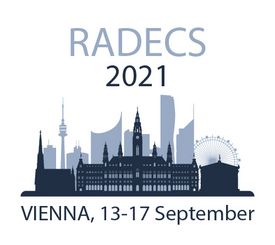D-1: Impact of the Data Retention Threshold Voltage on the Cell-to-Cell SEU Sensitivity of COTS SRAMs
M. Rezaei1, A. Arinero Panduro2, F. Franco2, J. Fabero3, H. Mecha2, M. Letiche3, H. Puchner4, J. Clemente2
1 Universidad Complutense de Madrid / Departamento de Arquitectura de Computadores y Automática / Facultad de lnformática, Spain
2 Universidad Complutense de Madrid, Spain
3 Institut Laue Langevin, France
4 Infineon Technologies, USA
An experimental study on the cell-to-cell sensitivity of 65-nm, 90-nm and 130-nm volatile bulk COTS SRAMs to thermal neutron irradiation is presented. Results show a dependency between VDR and the number of bitflips after irradiation.
D-2: Assessment of Machine Learning Models in Computing System under Neutron Radiation
M. Trindade1, J. Brum1, L. Maldaner1, R. Garibotti2, L. Ost3, R. Possamai Bastos1
1 Laboratoire TIMA, France
2 School of Technology, Pontifical Catholic University of Rio Grande do Sul, Brazil
3 Loughborough University, United Kingdom
This paper compares the effectiveness of three machine learning models running on a low-power processor under neutron radiation. Results suggest that our implementations retain a certain level of effectiveness even without mitigation techniques.
D-3: Neutron-induced Faults on CNN for Aerial Image Classification on SRAM-based FPGA Using Softcore GPU and HLS
F. Benevenuti1, M. Gonçalves1, E. Pereira Jr2, R. Galhardo Vaz2, O. Gonçalez2, J. Azambuja1, F. Lima Kastensmidt1
1 Universidade Federal do Rio Grande do Sul, Brazil
2 Departamento de Ciência e Tecnologia Aeroespacial, Brazil
This work evaluates neutron-induced SEUs in image classification all-convolutional neural networks implemented an SRAM-based FPGA: one running in softcore GPU and one in HLS design. Reliability, area, execution time and power are discussed.
PD-2: Characterization of the Total Charge for SET Voltage Pulses in a Commercial 65 nm CMOS Technology
Z. Li1,2, L. Berti1, B. Vignon1, P. Leroux2
1 IMEC, Belgium
2 Leuven University, Belgium
This paper SET charge measurement circuits and results for a commercial 65 nm CMOS technology. The chip has been tested under the heavy-ion beam with an effective LET from 20.4 to 88.35 MeVcm2/mg.
PD-3: Assessment of Attitude Estimation Processing System under Neutron Radiation Effects
T. Kraemer Sarzi Sartori1,2, H. Fourati2, M. Garay Trindade1, R. Possamai Bastos1
1 Université Grenoble Alpes/TIMA, France
2 Université Grenoble Alpes/GIPSA-Lab, France
This paper assesses the effectiveness of an Attitude Estimation (AE) processing system in tolerating neutron radiation-induced soft errors. Radiation tests have been conducted on an advanced AE algorithm running on a processing system neutron radiation.
PD-4: Reliability evaluation of low-power GPU-accelerated System-on-Chip under proton radiation
J. Badia1, G. Leon1, J. Belloch2, A. Lindoso2, M. Garcia-Valderas2, L. Entrena2
1 Universitat Jaume I de Castellón, Spain
2 Universidad Carlos III de Madrid, Spain
In this paper we evaluate the influence of the parallelization strategy on the proton radiation reliability of LU decomposition on a GPU-accelerated System-on-Chip. More intensive utilization of GPU resources produce larger cross-sections.
PD-5: Experimental Test Approach for SEFI Categorization in Microprocessors
S. Houssany1, N. Guibbaud1, F. Miller1, T. Cheviron1, T. Colladant2
1 Nuclétudes, France
2 DGA, France
An experimental test approach to sort the different kinds of SEFI in microprocessors is presented. lt relies on the configuration and use of the interrupt handler combined with an external watchdog.
PD-6: lnvestigation and Simulation of SEL Cross Sections at Different Temperatures
E. Mrozovskaya1, P. Chubunov1, S. lakovlev2, G. Zebrev1
1 National Research Nuclear University MEPhl, Russian Federation
2 JSC Institute of Space Device Engineering, Russian Federation
The Single Event Latchup cross sections as functions of LET in different CMOS circuits were experimentally investigated at different temperatures. A simplified simulation method for the SEL cross section temperature dependence is proposed and validated.
PD-7L: 7nm FinFET technology heavy ion SEL evaluation using Xilinx Versal as case study
A. Dufour1, J. Carron1, F. Pierron2, D. Dangla1, G. Bascoul1, F. Bezerra1, J. Mekki1, P. Maillard3
1 CNES, France
2 Bibench, France
3 Xilinx, USA
This paper presents the test setup and first SEL results recently obtained under heavy ions on 7nm FinFET Xilinx Versal™, the latest product proposed by Xilinx. We also analyze small current variations observed under beam.
PD-8L: Evaluation of Xilinx Deep Processing Unit (DPU) under Neutron Irradiation
D. Agiakatsikas1, N. Foutris2, A. Sari1, V. Vlagkoulis1, I. Souvatzoglou1, M. Psarakis1, M. Lujan2, M. Kastriotou3, C. Cazzaniga3
1 Dept. of Informatics, University of Piraeus, Greece
2 Dept. of Computer Science, The University of Manchester, United Kingdom
3 ISIS Facility, STFC, Rutherford Appleton Laboratory, United Kingdom
The paper studies the dependability of the Xilinx Deep-Learning Processing Unit (DPU) under neutron irradiation. It analyzes the impact of SEEs on the accuracy of a DPU running the resnet50 model on a Ultrascale+ MPSoC.














